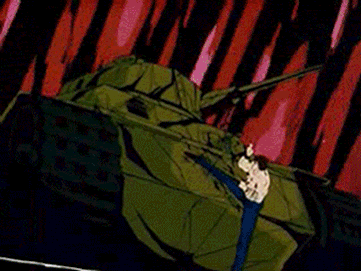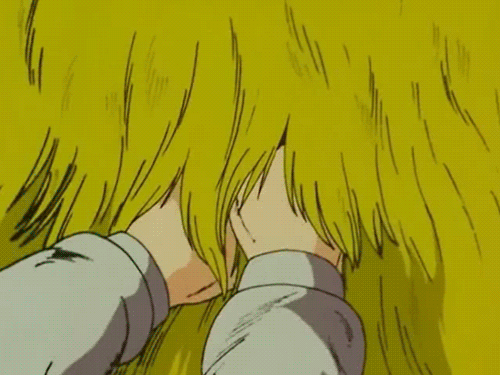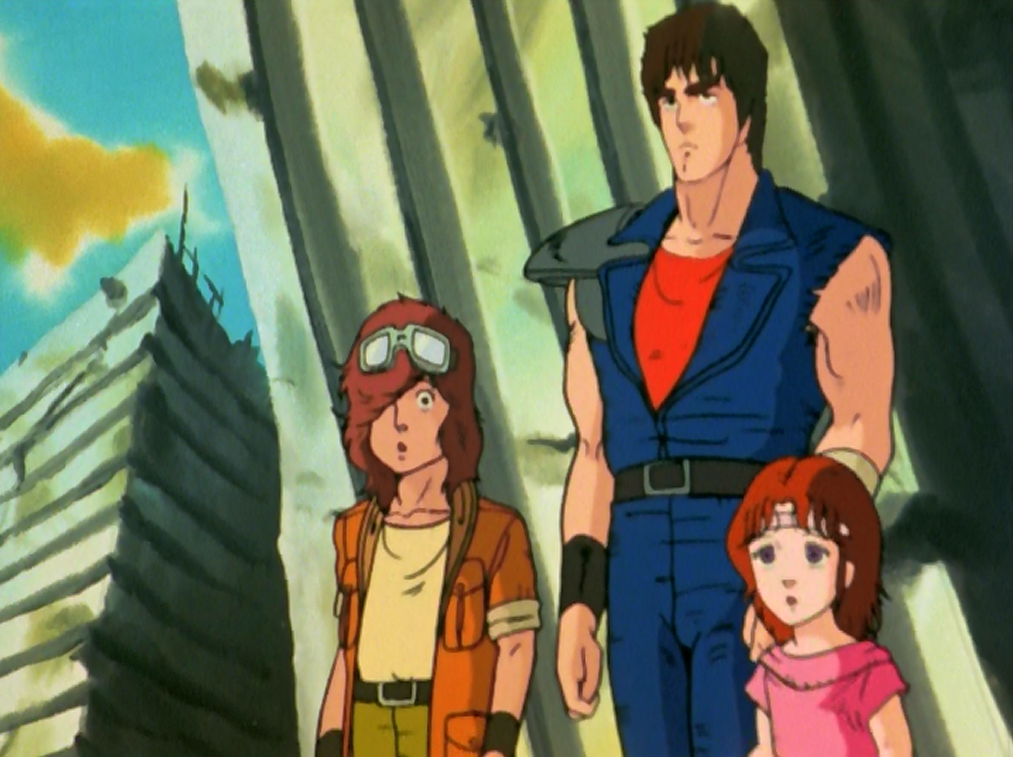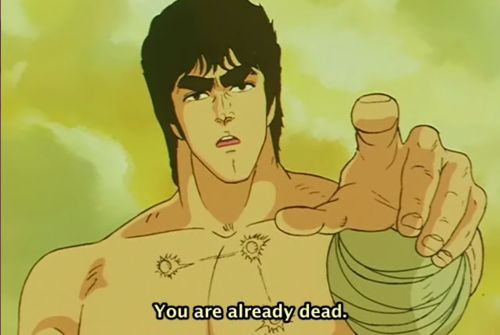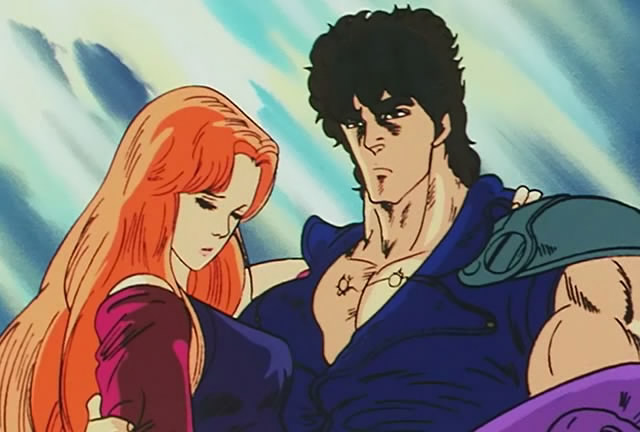The Hokuto no Ken manga is a bit deeper and more mature than the anime. Therefore, the anime’s better. Like most great traditional anime, Hokuto no Ken virtue lies precisely in its formulaicness; it’s so formal that it approaches folklore.
There are no
people in it. Shin broods in the dark; he sits atop a large stone throne in a tall, impossibly shadowy room, reposing diagonally in an imposing yet relaxed posture, sipping red-wine, his long flowing golden hair a match to the long flowing King’s cloak tastefully thrown over a single shoulder; “Kenshiro”, his face scowls with a hint of anger.
Can you imagine you, a human being, living like this? You wake up to another post-apocalyptic day, lazily dragging yourself from bed; you rinse your mouth and eat some sweet confiscated fruit; you choose a cloak from the cloak-closet (“let’s try the silver sable today”), demand a wine cup from your slaves, sit diagonally in an imposing yet relaxed posture, and broods speaking out loud to no one: “I’ve kidnapped her after torturing her dear boyfriend and leaving him to death right before her eyes, how could she
possibly not love me?”.
How about also, “Being a captive of this rapist bloodthirsty tyrant is so boring, I guess I’ll wear long flowing silky dresses and play the harp all day”—or: “In a world where there’s scarcely any food left, the best way to raise a strong army clearly is to kill two or three soldiers every training session just to prove I’m such a tough colonel”: True Anime Characters.
Yuria (in her first incarnation) is a damsel-in-distress and nothing else; she doesn’t
need to be anything else, for that’s all the plot demands.
Shin has no pretension of verisimilitude; his sole reason for being is being eventually punched by Kenshiro. Shin is just a portrait of arrogance.
And Kenshiro’s just a portrait of… power. That he grows ever more melancholic and compassionate is unexpectedly sensitive from the part of the author’s, but this too arises naturally from the nature of power.
Kenshiro is not Captain America or He-Man or Kratos; by which I mean, he’s totally not a jerk. He’s Atlas and Prometheus and Hercules; he bears alone the weight of the world, and he brings revolution to the peoples, and—last but not least—he kills the bad guys.
I’ve been known to watch anime skipping the entire filler arcs altogether (and I stand by it). With Hokuto no Ken the opposite holds. The filler chapters, with their monster-of-the-week simplicity, are the ones that fascinate me, with an hypnotic power rivaled only by Sailor Moon. Kenshiro arrives somewhere, the silent wanderer; he won’t ever speak, except to tell the enemy the precise, sadistic details of how he’s already dead (“I pressed your shikajika secret point; now you’ll won’t be able to stop walking to the volcano”, etc).
Bat exists not only for comic relief, but to support Ken’s silence; he makes the expositions Ken couldn’t without ruining his stoic/macho image. We meet some hardworking, honest, innocent people. We meet bad guys, generally mooks in mohawks and heavy metal mad max wear; they tragically murder some of the people. Children are safe, in the anime (the manga kills children, the anime doesn’t); but if a kid likes some adult, he’s as good as dead. (Often children
like adults in a disturbing way; notably, Lin/Kenshiro is a purebred moé relationship).
For some lame excuse or another, Kenshiro couldn’t stop the murders; he sheds a manly tear. Then he walks alone, slow and unstoppable like destiny, “serene and infallible like Bruce Lee”—literally like Bruce Lee; he wasn’t that much of a Bruce ploitation character in the manga, but the anime makes him twice as similar and adds bona fide Bruce Lee Noises to boot; it all works surprisingly well. He finds the bad guys; he warns them, for God is ever merciful, but they choose to ignore reason and do something awful that proves their irredeemable evilness.
They have just earned God’s own red-hot Wrath. Ken rips his shirt; no one knows where he finds a new identical one every episode.
(“Hokuto no Shirt Regeneration” has been proposed).
Ken, dancing gracefully, EXPLODES THE HELL OUT of everyone in sheer pure exquisite fury.
He then explodes or otherwise maim and murder the big boss (and source of evil) with well-deserved supernatural cruelty.
Omae wa mou shindeiru is evoked religiously like a mantra; the catchphrase, much more frequent in the anime, works as another recurring structural property.We don’t see blood except whited out in sillhouette—which means it speaks directly to imagination; the anime’s censorship, again, is a restriction that works to heighten the overall effect.
The area is now clean. The surviving citizens swear they’ll be forever grateful. We’ll never see them again.
We’ll never even hear of the bad guys again. Start a new episode: the whole thing repeats, iterating over itself like a clock pendulum.
Hokuto no Ken is some kind of borderline-mythical popcorn entertainment, owes its power to Bruce.
Kenshiro can be perfect because Bruce remains the perfect action hero. So far no one ever came close to constructing such a fascinating idol, to fine-tune so perfectly the gears of charisma and awe (probably because no one has sweated that much in pursuit of the ideal).
Hokuto no Ken is Bruce Lee in the world of Mad Max with gory superpowers and a not-so-subtle streak of
mono-no-aware fatalism.
Unable to rise away from the social problems of its historical conditions, this anime is (like most) openly sexist, classist, homophobic, and at times pedophilic; the author, Sho Fumimura, is even more misogynistic than the average mangaka; these are serious issues that deserves awareness and criticism—but, if you can tolerate the social problems and put them aside for a moment, the power-fantasy of Hokuto no Ken is… Beautiful. It knows what it’s out to do, and does it. Watch it drinking shochu. Sing the songs. A classic anime at it's best.
On a side note, while many love "Ai o Torimodose!!" for it's nostalgia, my personal favorite is "Silent Survivor".
Those drums at the end get me every time.










